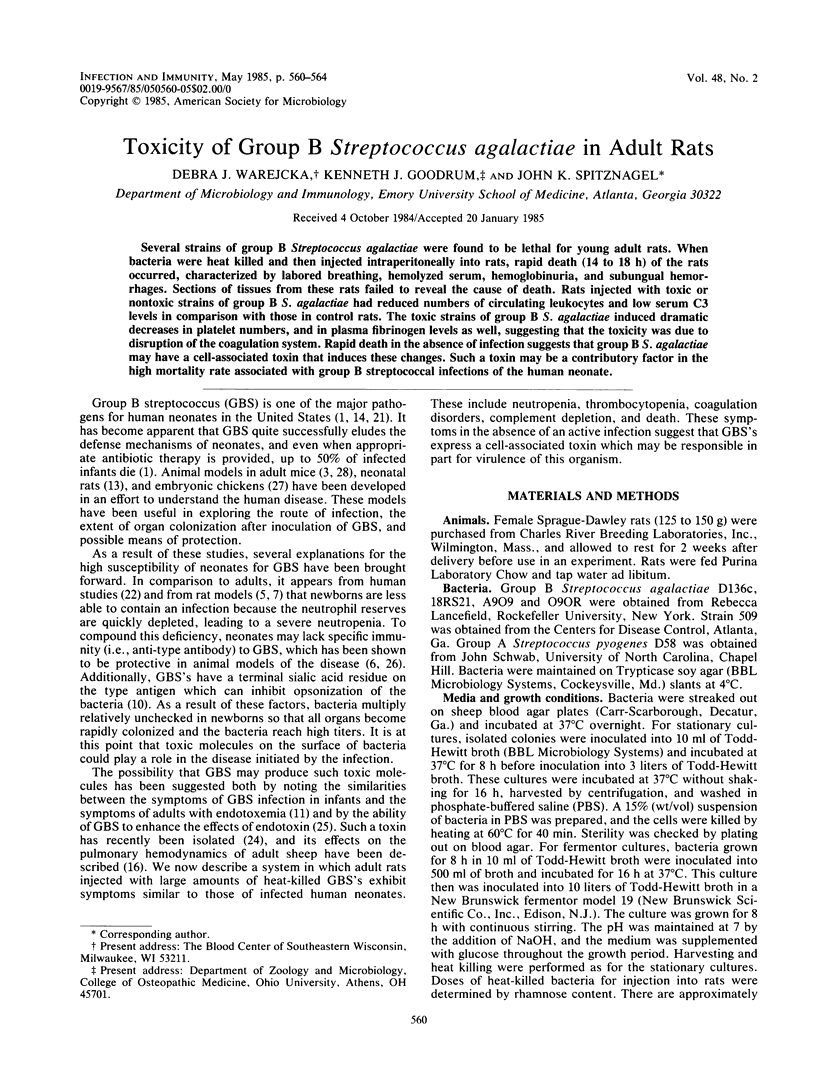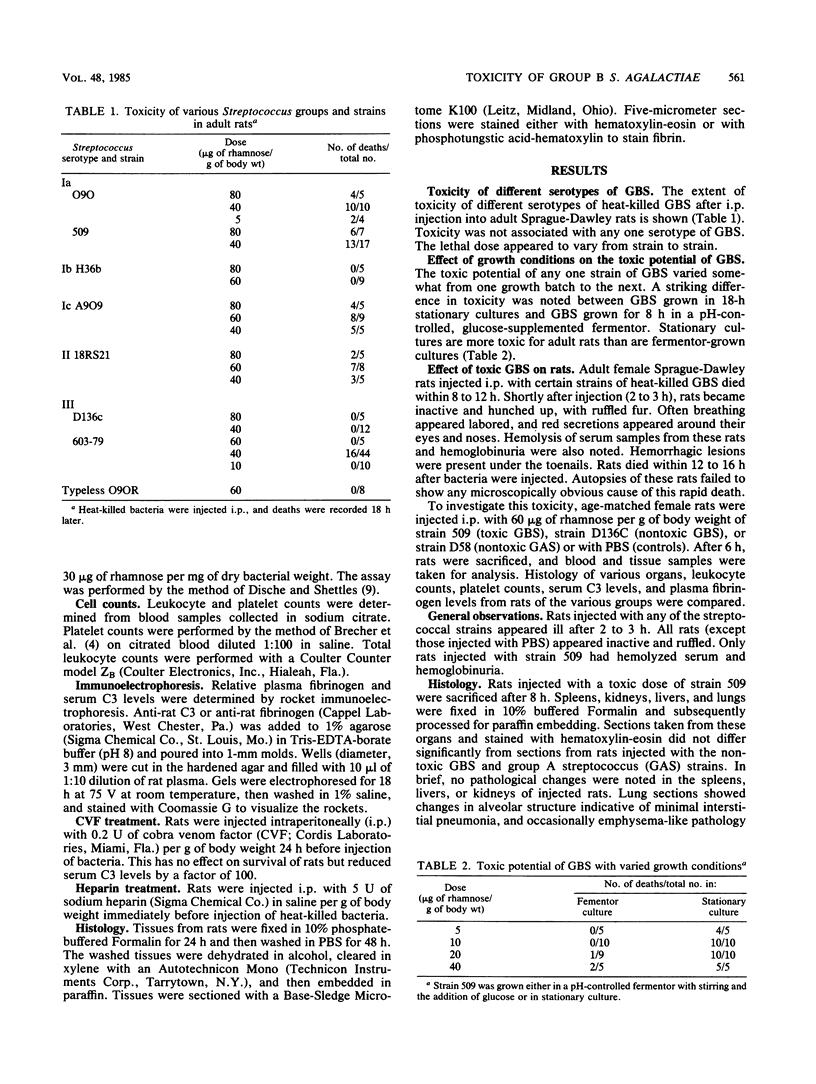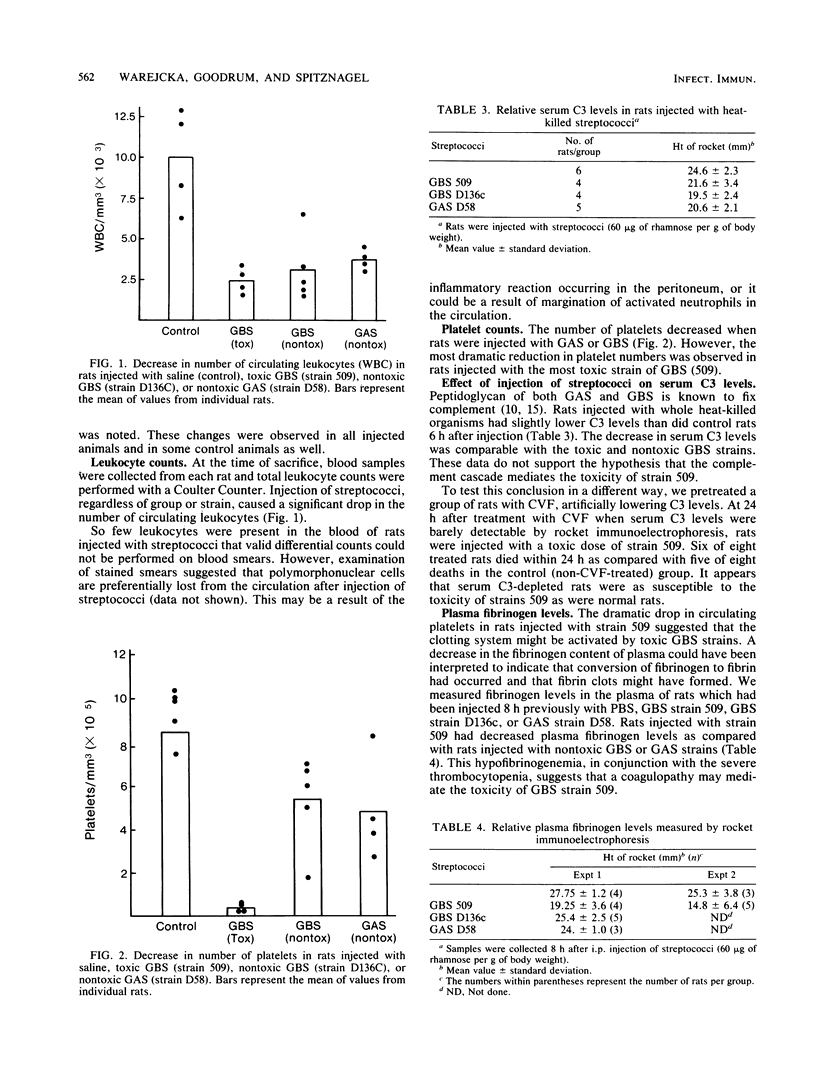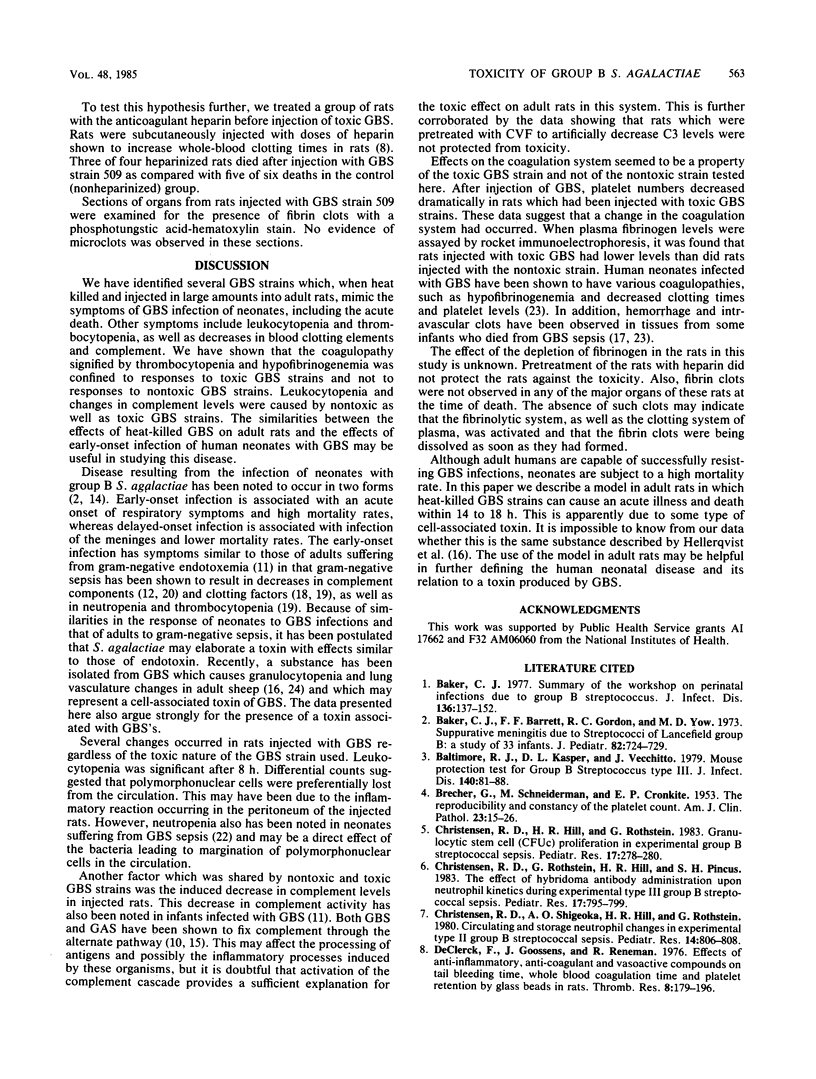Abstract
Several strains of group B Streptococcus agalactiae were found to be lethal for young adult rats. When bacteria were heat killed and then injected intraperitoneally into rats, rapid death (14 to 18 h) of the rats occurred, characterized by labored breathing, hemolyzed serum, hemoglobinuria, and subungual hemorrhages. Sections of tissues from these rats failed to reveal the cause of death. Rats injected with toxic or nontoxic strains of group B S. agalactiae had reduced numbers of circulating leukocytes and low serum C3 levels in comparison with those in control rats. The toxic strains of group B S. agalactiae induced dramatic decreases in platelet numbers, and in plasma fibrinogen levels as well, suggesting that the toxicity was due to disruption of the coagulation system. Rapid death in the absence of infection suggests that group B S. agalactiae may have a cell-associated toxin that induces these changes. Such a toxin may be a contributory factor in the high mortality rate associated with group B streptococcal infections of the human neonate.
Full text
PDF




Selected References
These references are in PubMed. This may not be the complete list of references from this article.
- BRECHER G., SCHNEIDERMAN M., CRONKITE E. P. The reproducibility and constancy of the platelet count. Am J Clin Pathol. 1953 Jan;23(1):15–26. doi: 10.1093/ajcp/23.1.15. [DOI] [PubMed] [Google Scholar]
- Baker C. J., Barrett F. F., Gordon R. C., Yow M. D. Suppurative meningitis due to streptococci of Lancefield group B: a study of 33 infants. J Pediatr. 1973 Apr;82(4):724–729. doi: 10.1016/s0022-3476(73)80606-7. [DOI] [PubMed] [Google Scholar]
- Baltimore R. S., Kasper D. L., Vecchitto J. Mouse protection test for group B Streptococcus type III. J Infect Dis. 1979 Jul;140(1):81–88. doi: 10.1093/infdis/140.1.81. [DOI] [PubMed] [Google Scholar]
- Christensen R. D., Hill H. R., Rothstein G. Granulocytic stem cell (CFUc) proliferation in experimental group B streptococcal sepsis. Pediatr Res. 1983 Apr;17(4):278–280. doi: 10.1203/00006450-198304000-00010. [DOI] [PubMed] [Google Scholar]
- Christensen R. D., Rothstein G., Hill H. R., Pincus S. H. The effect of hybridoma antibody administration upon neutrophil kinetics during experimental type III group B streptococcal sepsis. Pediatr Res. 1983 Oct;17(10):795–799. doi: 10.1203/00006450-198310000-00005. [DOI] [PubMed] [Google Scholar]
- Christensen R. D., Shigeoka A. O., Hill H. R., Rothstein G. Circulating and storage neutrophil changes in experimental type II group B streptococcal sepsis. Pediatr Res. 1980 Jun;14(6):806–808. doi: 10.1203/00006450-198006000-00006. [DOI] [PubMed] [Google Scholar]
- De Clerck F., Goossens J., Reneman R. Effects of anti-inflammatory, anticoagulant and vasoactive compounds on tail bleeding time, whole blood coagulation time and platelet retention by glass beads in rats. Thromb Res. 1976 Feb;8(2):179–193. doi: 10.1016/0049-3848(76)90261-9. [DOI] [PubMed] [Google Scholar]
- Edwards M. S., Kasper D. L., Jennings H. J., Baker C. J., Nicholson-Weller A. Capsular sialic acid prevents activation of the alternative complement pathway by type III, group B streptococci. J Immunol. 1982 Mar;128(3):1278–1283. [PubMed] [Google Scholar]
- Fearon D. T., Ruddy S., Schur P. H., McCabe W. R. Activation of the properdin pathway of complement in patients with gram-negative of bacteremia. N Engl J Med. 1975 May 1;292(18):937–940. doi: 10.1056/NEJM197505012921802. [DOI] [PubMed] [Google Scholar]
- Fenton L. J., Strunk R. C. Complement activation and group B streptococcal infection in the newborn: similarities to endotoxin shock. Pediatrics. 1977 Dec;60(6):901–907. [PubMed] [Google Scholar]
- Ferrieri P., Burke B., Nelson J. Production of bacteremia and meningitis in infant rats with group B streptococcal serotypes. Infect Immun. 1980 Mar;27(3):1023–1032. doi: 10.1128/iai.27.3.1023-1032.1980. [DOI] [PMC free article] [PubMed] [Google Scholar]
- Franciosi R. A., Knostman J. D., Zimmerman R. A. Group B streptococcal neonatal and infant infections. J Pediatr. 1973 Apr;82(4):707–718. doi: 10.1016/s0022-3476(73)80604-3. [DOI] [PubMed] [Google Scholar]
- Greenblatt J., Boackle R. J., Schwab J. H. Activation of the alternate complement pathway by peptidoglycan from streptococcal cell wall. Infect Immun. 1978 Jan;19(1):296–303. doi: 10.1128/iai.19.1.296-303.1978. [DOI] [PMC free article] [PubMed] [Google Scholar]
- Hellerqvist C. G., Rojas J., Green R. S., Sell S., Sundell H., Stahlman M. T. Studies on group B beta-hemolytic Streptococcus. I. Isolation and partial characterization of an extracellular toxin. Pediatr Res. 1981 Jun;15(6):892–898. doi: 10.1203/00006450-198106000-00002. [DOI] [PubMed] [Google Scholar]
- Hey D. J., Hall R. T., Burry V. F., Thurn A. N. Neonatal infections caused by group B streptococci. Am J Obstet Gynecol. 1973 May 1;116(1):43–47. doi: 10.1016/0002-9378(73)90881-8. [DOI] [PubMed] [Google Scholar]
- Levin J., Poore T. E., Young N. S., Margolis S., Zauber N. P., Townes A. S., Bell W. R. Gram-negative sepsis: detection of endotoxemia with the limulus test. With studies of associated changes in blood coagulation, serum lipids, and complement. Ann Intern Med. 1972 Jan;76(1):1–7. doi: 10.7326/0003-4819-76-1-1. [DOI] [PubMed] [Google Scholar]
- Mason J. W., Kleeberg U., Dolan P., Colman R. W. Plasma kallikrein and Hageman factor in Gram-negative bacteremia. Ann Intern Med. 1970 Oct;73(4):545–551. doi: 10.7326/0003-4819-73-4-545. [DOI] [PubMed] [Google Scholar]
- McCabe W. R. Serum complement levels in bacteremia due to gram-negative organisms. N Engl J Med. 1973 Jan 4;288(1):21–23. doi: 10.1056/NEJM197301042880105. [DOI] [PubMed] [Google Scholar]
- McCracken G. H., Jr Group B streptococci: the new challenge in neonatal infections. J Pediatr. 1973 Apr;82(4):703–706. doi: 10.1016/s0022-3476(73)80603-1. [DOI] [PubMed] [Google Scholar]
- Quirante J., Ceballos R., Cassady G. Group B beta-hemolytic streptococcal infection in the newborn. I. Early onset infection. Am J Dis Child. 1974 Nov;128(5):659–665. doi: 10.1001/archpedi.1974.02110300069009. [DOI] [PubMed] [Google Scholar]
- Rojas J., Green R. S., Hellerqvist C. G., Olegard R., Brigham K. L., Stahlman M. T. Studies on group B beta-hemolytic Streptococcus. II. Effects on pulmonary hemodynamics and vascular permeability in unanesthetized sheep. Pediatr Res. 1981 Jun;15(6):899–904. doi: 10.1203/00006450-198106000-00003. [DOI] [PubMed] [Google Scholar]
- Schlievert P. M., Varner M. W., Galask R. P. Endotoxin enhancement as a possible etiology of early-onset group B beta-hemolytic streptococcal sepsis in the newborn. Obstet Gynecol. 1983 May;61(5):588–592. [PubMed] [Google Scholar]
- Summary of the workshop on perinatal infections due to group B Streptococcus. J Infect Dis. 1977 Jul;136(1):137–152. doi: 10.1093/infdis/136.1.137. [DOI] [PubMed] [Google Scholar]
- Tieffenberg J., Vogel L., Kretschmer R. R., Padnos D., Gotoff S. P. Chicken embryo model for type III group B beta-hemolytic streptococcal septicemia. Infect Immun. 1978 Feb;19(2):481–485. doi: 10.1128/iai.19.2.481-485.1978. [DOI] [PMC free article] [PubMed] [Google Scholar]
- Wennerstrom D. E., Schutt R. W. Adult mice as a model for early onset group B streptococcal disease. Infect Immun. 1978 Feb;19(2):741–744. doi: 10.1128/iai.19.2.741-744.1978. [DOI] [PMC free article] [PubMed] [Google Scholar]


